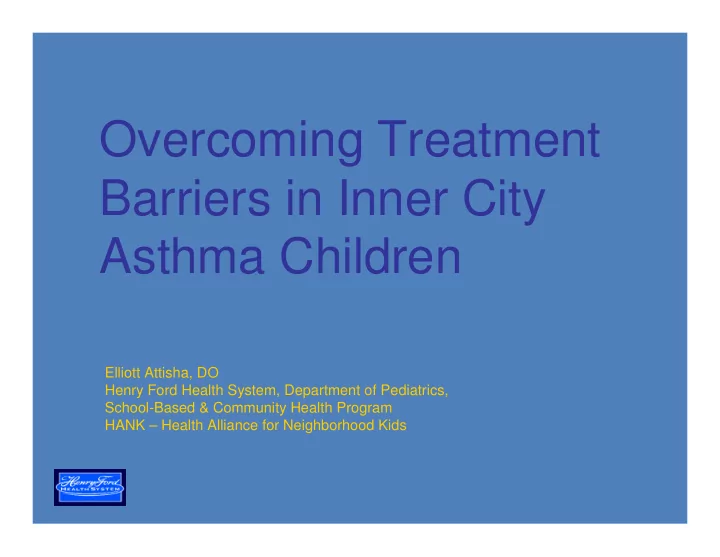

Overcoming Treatment Barriers in Inner City Asthma Children Elliott Attisha, DO Henry Ford Health System, Department of Pediatrics, School-Based & Community Health Program HANK – Health Alliance for Neighborhood Kids
Agenda 1. Background 2. Provider and Patient Education 3. Tools 4. Our Initiative 5. Closing Thoughts
Asthma Data • Most common chronic disease of childhood • In the US, 7 million children under 18 have asthma – 1 out of 10 school-age children – More than half with at least one asthma attack in last year • Disproportionately higher number of asthmatics in low income, inner city environments. National Asthma Control Initiative
Across the country, 13 million missed school days each year due to asthma! Source: National Asthma Control Initiative
A Quick Fix? • Implementing evidence-based clinical practice guidelines for asthma has demonstrated effectiveness. • Challenges – getting most clinicians to implement guideline-based care for their asthma patients – Getting patients to adhere to their treatment plan National Asthma Control Initiative
Provider Team Asthma Literacy
Checklist � Basic understanding of asthma, including physiology � A proper office note � Understanding and knowing how to address triggers � Use of available tools such as ACT � How to classify severity and control of asthma � Understanding asthma medications and the Step Therapy approach � Knowing how to build an education and action plan � Understanding concept of teach back and promotion of self-management � Ensuring adequate patient follow-up
6 priority messages of the National Asthma Control Initiative • Use inhaled corticosteroids • Use asthma action plans • Assess asthma severity • Assess and monitor asthma control • Schedule follow-up visits • Control environmental exposure National Asthma Control Initiative
Asthma Triggers Odors & Perfume Pollen Food Allergies Mold Dust Weather Changes Cleaning Products Colds and Viruses Dogs Hot or Cold Air
Childhood Asthma Control Test ACT
Severity, Control and Step-Therapy EPR-3 (8/28/07): p326-343
Program developed by Michigan asthma and practice redesign experts to help clinicians make diagnosis and care decisions based on the EPR-3 asthma guidelines, and incorporate the tools below into their everyday practice. – Questions About Your Breathing – Asthma Control Test™ (ACT™) – Asthma Diagnosis Tool – Asthma Patient Follow-Up Tool – Stepwise Approach to Managing Asthma
Patient Education
Checklist � Basic facts about asthma � Differentiating long-term and quick-relief medications � Identifying and avoiding environmental exposures � Taking medications correctly � Self-monitoring � Importance of asthma action plan South Bronx Asthma Partnership
South Bronx Asthma Partnership
Asthma Action Plan Feel Good Zone � Not Feeling well � Feeling Very Sick �
Goals of Asthma Treatment • Be active without having asthma symptoms • Sleep through the night without having symptoms • Prevent asthma episodes • Reduce emergency room visits and hospitalizations • Reduce school/work absence because of asthma • Not be worried about having asthma South Bronx Asthma Partnership
DETROIT!
Wayne County/Detroit Michigan Data • Widespread disparities exist in the diagnosis, management and health outcomes of inner city children with asthma • Asthma prevalence among Detroit children is more than double the national rate – a majority of these children do not have an ongoing relationship with a primary care physician • Number of children in Wayne County <18 years old with asthma 38,928 • Children (<18 years) with asthma that have visited an emergency room for 9.5% asthma 2 or more times in the past year • Michigan children with persistent asthma that are filling prescriptions for 30% inhaled steroids • Michigan children with current asthma that have ever received an asthma 40.2% action plan Source: Asthma Initiative of Michigan
Challenges that inner city children face when accessing health care are quite overwhelming. •Specific to Detroit • Limited availability of providers • Lack of reliable transportation • Low literacy rates
Henry Ford’s School-Based and Community Health Program has helped to alleviate many of the barriers. • Bringing health care directly to the child • 9 School-Based Health Centers • 1 Mobile Clinic - CHF partnership
While school-based and mobile clinics have alleviated many of the barriers, access and compliance to prescribed medication regimens remains a challenge.
Thinking Outside of the Box –Through an innovative school- based medication delivery program, we hope to alleviate some of these barriers.
A Basic Overview of program application to asthma patients � Patient seen and evaluated at school or mobile clinic � Prescription is sent to Henry Ford’s outpatient pharmacy through EMR � Same day delivery to the school � Medication is billed to patient’s insurance � Hands-on education on technique/proper use � Pictorial-based action plan to help with literacy barriers � Eventual transition of refills to mail delivery.
Recent Expansion of Asthma Program • Addition of a Nurse to the team – Pilot initiated 6 months ago – Responsibilities: » Oversee asthma patients at each of the mobile clinic sites » Pre-visit intake » Patient education, » Delivery coordination, » Triage and scheduling » Education sessions for staff of school • Transition to Electronic Medical Records
Potential Benefits of Program: –Reduced number of missed school days –Reduced work loss for parents –Reduced ER and physician visits –Reduced health care costs –Improved quality of life
In the end, we hope to show that our medication delivery program along with reinforced patient education can overcome some of the current barriers and eventually lead to improved outcomes.
As you treat asthma patients please think about the following: • Excellence in medical treatment is worthless if the patient doesn’t take (or get!) the medication. • Compliance is closely linked to clinician communication and patient education. • Most clinicians believe they are good communicators, but most patients feel clinician communication and education is inadequate. ��������������������������������������� Source: South Bronx Asthma Partnership
Thank You! Elliott Attisha, DO FAAP HANK – Health Alliance For Neighborhood Kids Department of Pediatrics School-Based & Community Health Program Henry Ford Health System
Recommend
More recommend